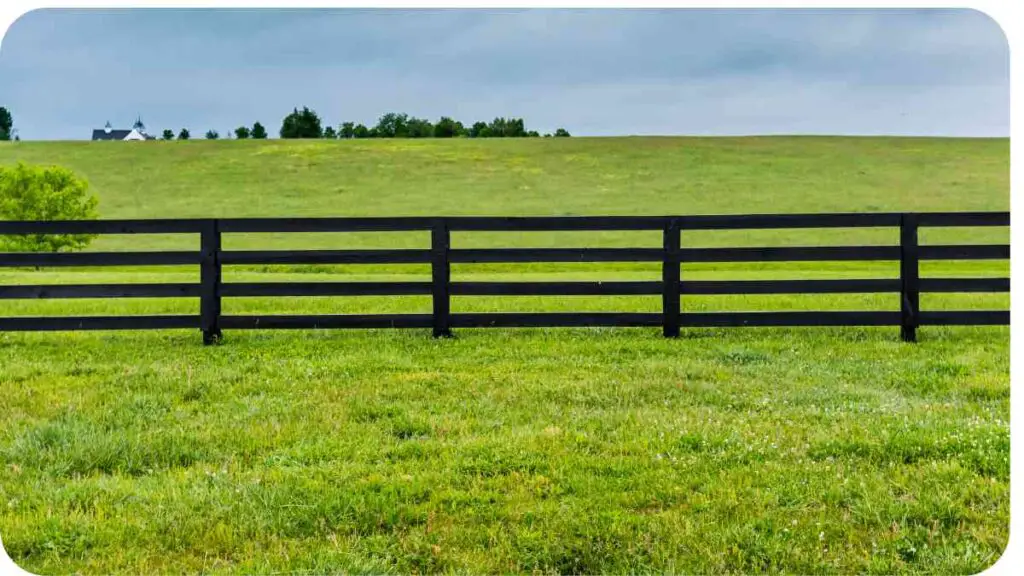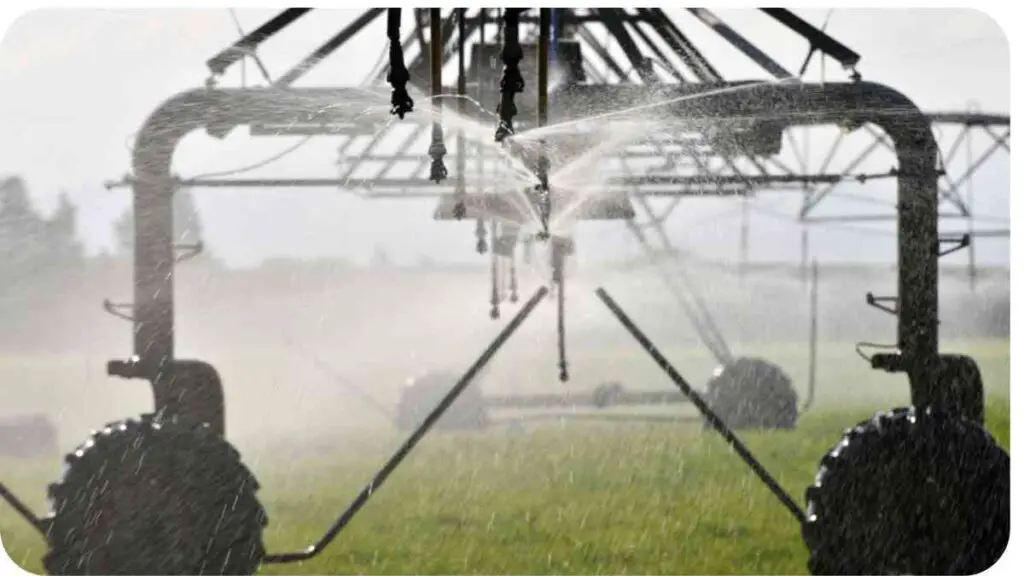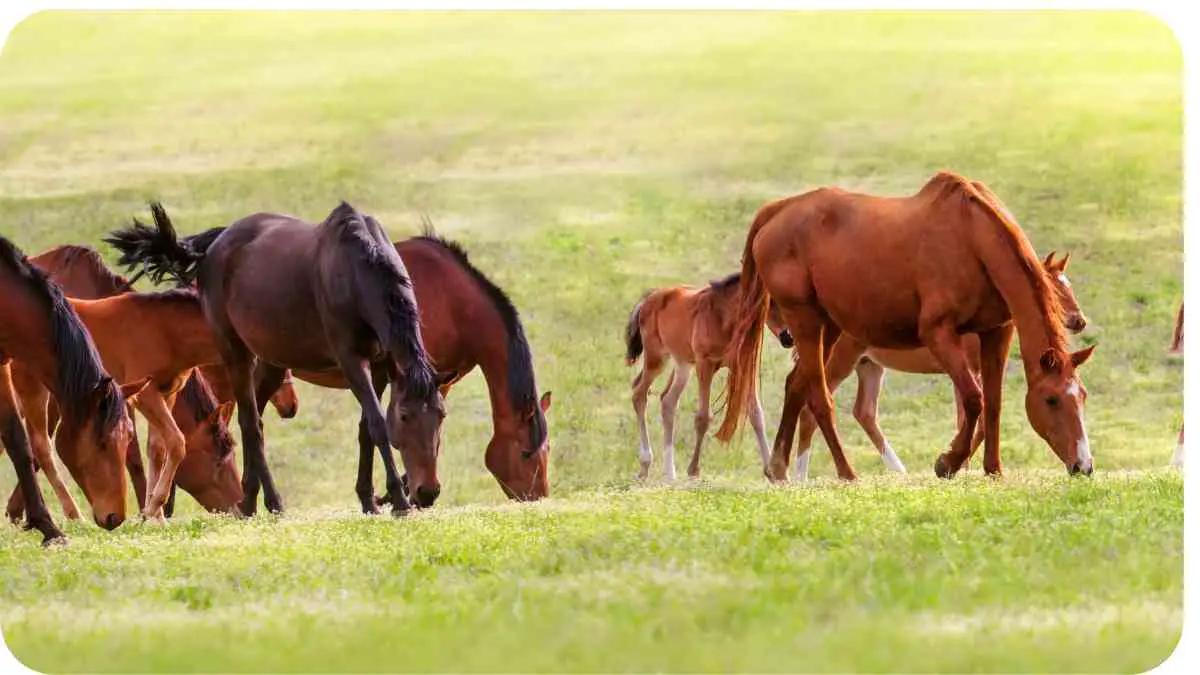Welcome to this comprehensive guide on horse pasture management. As a professional with years of experience in the field, I understand the importance of maintaining healthy pastures for the well-being of our equine friends.
In this article, we will explore essential tips and tricks to help you effectively manage your horse pastures, ensuring optimal nutrition, safety, and overall pasture health.
| Takeaways |
| Proper grazing management is crucial for maintaining healthy pastures and providing adequate nutrition to horses. |
| Implementing a rotational grazing system helps prevent overgrazing and promotes even nutrient distribution in pastures. |
| Allowing pastures sufficient rest and recovery periods supports grass regrowth and long-term pasture health. |
| Aeration techniques, such as core aeration and solid-tine aeration, can improve soil compaction and promote healthy root development. |
| Understanding horses’ nutritional needs and supplementing their diets when necessary helps maintain their overall health and pasture productivity. |
| Ensuring horses have access to clean and fresh water is essential for their hydration and well-being. |
| Integrated pest management techniques help control pasture pests and minimize pesticide use. |
| Regular maintenance of pastures and equipment, such as mowing and equipment inspections, ensures optimal performance and safety. |
| Consider seasonal considerations, such as spring overseeding, summer heat management, and winter preparation, for effective pasture management. |
| Staying informed about best practices through further reading and seeking expert advice contributes to successful pasture management. |
2. Why is Horse Pasture Management Important?
Proper pasture management is vital for the health and well-being of your horses. It not only ensures a natural habitat for them but also contributes to their overall nutrition and reduces the risk of health issues. Well-managed pastures provide horses with exercise, fresh air, and the opportunity to graze freely, mimicking their natural behavior.
When pastures are not managed correctly, they can become overgrazed, weed-infested, or susceptible to erosion, negatively affecting both the horses and the environment.
Proper forage is crucial for your horse’s health and nutrition. Learn more about the significance of forage in a horse’s diet and how it relates to pasture management.
3. Factors to Consider for Horse Pasture Management

3.1 Soil Quality and Testing
One of the first steps in managing horse pastures is assessing the soil quality. Conducting soil tests helps determine the nutrient composition of the soil and identifies any deficiencies or imbalances. Based on the test results, you can develop a fertilizer or amendment plan to improve soil fertility and maximize pasture productivity.
3.2 Fencing and Grazing Rotation
A properly fenced pasture is essential for maintaining horse safety and managing grazing patterns. Rotational grazing is a proven technique that involves dividing the pasture into smaller sections or paddocks. By rotating horses between paddocks, you allow the grass time to regenerate and prevent overgrazing, which can lead to bare patches and weed growth.
Hoof Care 101″ is essential to keep your horse’s feet healthy. Discover the best practices for maintaining your horse’s hooves and how it complements pasture management.
Table: Fencing and Grazing Rotation
| Fencing Types | Pros | Cons |
| Wooden | Durable and aesthetically appealing | Expensive to install and maintain |
| Electric | Cost-effective and easy to install | Requires regular maintenance |
| Polymer-coated | Safe and durable | Initial cost might be higher |
3.3 Weed Control and Pasture Renovation
Weed control is crucial for maintaining healthy pastures. Weeds compete with grass for nutrients, sunlight, and space. Regular monitoring and timely intervention are necessary to prevent weed infestation. Pasture renovation techniques, such as overseeding or reseeding, can help restore damaged or overly grazed areas, improving the overall health and productivity of the pasture.
Table: Common Pasture Weeds and Control Methods
| Weed Name | Control Methods |
| Canada Thistle | Mowing, herbicides, or hand-pulling |
| Dandelion | Herbicides or hand-pulling |
| Common Mallow | Herbicides or hand-pulling |
| Yellow Star Thistle | Herbicides or biological control |
4. Proper Grazing Techniques for Healthy Pastures
Effective grazing management plays a crucial role in maintaining healthy pastures and ensuring horses receive the necessary nutrition. Here are some essential tips for proper grazing techniques:
Protect your horse’s well-being by understanding common illnesses. Explore the implications and preventive measures for common horse illnesses within the context of pasture management.
4.1 Rotational Grazing
Implementing a rotational grazing system is highly beneficial for pasture health. By dividing the pasture into smaller paddocks and rotating horses between them, you allow the grass to recover and grow.
This practice reduces overgrazing, promotes even nutrient distribution, and minimizes the risk of weed encroachment. Keep track of the number of horses and adjust the grazing rotation accordingly to prevent overgrazing.
Table: Example Rotational Grazing Schedule
| Paddock | Grazing Period | Rest and Recovery Period |
| Paddock 1 | 1 week | 3 weeks |
| Paddock 2 | 1 week | 3 weeks |
| Paddock 3 | 1 week | 3 weeks |
4.2 Rest and Recovery Periods
Allowing sufficient rest and recovery periods for pastures is essential. During these periods, the grass can regrow and replenish its nutrient reserves. Overgrazing without adequate recovery time can lead to decreased productivity, soil erosion, and loss of valuable plant species. Monitoring grass height and implementing rest periods when the height reaches a certain level helps to ensure proper regrowth and long-term pasture health.
Ground Work” is a fundamental aspect of horse training. Learn why it’s an integral part of horse care and pasture management, and how you can enhance your horse’s behavior through ground work.
4.3 Pasture Aeration
Aeration is a valuable technique for promoting healthy pasture growth. By perforating the soil, you improve air and water circulation, nutrient absorption, and root development. Aerating compacted soils helps grass roots penetrate deeper, resulting in stronger and more resilient pastures. This technique is especially beneficial in high-traffic areas where horses tend to concentrate their grazing.
Table: Recommended Pasture Aeration Methods
| Aeration Method | Key Benefits |
| Core Aeration | Relieves soil compaction, facilitates root growth, and improves water infiltration |
| Solid-Tine Aeration | Reduces compaction, enhances nutrient uptake, and improves air and water circulation |
| Slit Seeding and Aeration | Combines aeration with overseeding for rejuvenating pastures and reducing weed encroachment |
| Liquid Aeration (Soil Surfactant) | Loosens compacted soil, enhances water retention, and stimulates root growth in dry or hard soils |
5. Feeding and Nutrition
Proper feeding and nutrition are vital for maintaining healthy horses and supporting pasture health. Understanding horses’ nutritional needs is essential to develop an appropriate feeding plan. In addition to grazing, providing supplemental feeding can help meet horses’ dietary requirements.
Is your horse losing weight? Discover the reasons and solutions. Explore how weight management plays a role in pasture care and get insights into addressing weight loss in horses effectively.
5.1 Understanding Horses’ Nutritional Needs
Horses require a balanced diet that includes forage, such as grass or hay, as the main component. Knowing the nutritional value of your pasture and supplementing it with hay or other appropriate feeds can help meet your horses’ requirements for protein, vitamins, minerals, and energy. Consult with a veterinarian or equine nutritionist to determine the most suitable diet for your horses based on their age, activity level, and overall health.
5.2 Supplemental Feeding
In certain situations, horses may need additional supplementation to fulfill their nutritional needs. This is especially important when the quality or quantity of forage is insufficient. Supplement options include commercial feeds, hay cubes, beet pulp, and micronutrient supplements. It is crucial to introduce supplements gradually and monitor your horses’ condition to ensure proper utilization and prevent digestive issues.
Table: Common Equine Supplements
| Supplement | Key Benefits |
| Vitamin and Mineral | Ensures balanced nutrition |
| Probiotics | Promotes healthy gut flora and digestion |
| Omega-3 Fatty Acids | Supports healthy skin, coat, and joints |
| Electrolytes | Replenishes electrolyte levels in hot weather |
6. Watering Systems and Hydration

Proper hydration is crucial for your horses’ health and overall well-being. Implementing an effective watering system is key to ensuring continuous access to clean and fresh water.
6.1 Adequate Water Sources
Provide multiple water sources throughout the pasture to encourage horses to drink regularly. This helps prevent dehydration and reduces the risks of colic and other health issues. Automatic waterers, troughs, and natural water sources such as ponds or streams can all be utilized to ensure consistent access to water.
6.2 Water Quality and Testing
Regularly testing the quality of the water sources is important. Poor water quality can impact horses’ health and reduce their willingness to drink. It is recommended to test for contaminants, such as bacteria, nitrates, and mineral content. If issues are detected, consider implementing water treatment methods such as filtration or treatment systems.
Table: Common Water Quality Parameters for Testing
| Parameter | Acceptable Range |
| pH level | 6.5-8.5 |
| Total Dissolved Solids (TDS) | <500 mg/L |
| Nitrate Level | <10 mg/L |
| Bacterial Contamination | Absence of coliform bacteria |
7. Managing Pasture Pests and Parasites
Proper pest and parasite control is crucial for maintaining healthy pastures and ensuring the well-being of your horses.
7.1 Integrated Pest Management
Implementing an integrated pest management (IPM) strategy helps control pests effectively while minimizing the use of pesticides. Some IPM techniques include regular pasture mowing, weed removal, biological control methods, and strategic insecticide applications when necessary.
7.2 Parasite Control
Effective parasite control is essential for the health of your horses. Regular deworming and manure management practices are key to minimizing the risk of parasite infestation. Consult with your veterinarian to develop an appropriate deworming schedule based on your horses’ individual needs, and ensure proper manure disposal or composting to prevent reinfestation.
Table: Common Equine Parasites and Control Methods
| Parasite | Control Methods |
| Small Strongyles | Regular deworming, pasture rotation, controlled grazing |
| Roundworms | Regular deworming, manure management |
| Tapeworms | Targeted deworming with specific medications |
| Bots | Seasonal deworming, proper manure disposal |
8. Pasture Maintenance and Equipment
Regular maintenance of your horse pastures and equipment is essential for optimal performance and long-term pasture health.
8.1 Mowing and Weed Trimming
Regular mowing helps control weed growth, maintain desired grass height, and prevent seed-head formation. Setting the mower at the appropriate height ensures that the grass is not cut too short, which can stunt growth and allow weeds to thrive.
In addition to mowing, trimming edges, fence lines, and around obstacles helps maintain a neat and tidy pasture appearance.
8.2 Equipment Maintenance
Proper maintenance of pasture equipment is necessary to ensure safe and efficient operation. Regularly inspect and service machinery such as tractors, mowers, and spreaders to keep them in good working condition. Properly functioning equipment promotes effective pasture management and reduces the risk of accidents.
Table: Essential Pasture Maintenance Equipment
| Equipment | Purpose |
| Tractor | For towing and powering various implements |
| Mower | Cutting grass and weed control |
| Drag Harrow | Leveling soil, breaking up manure, and spreading seeds |
| Spreader | Applying fertilizer, lime, or seed |
| Sprayer | Applying herbicides or other liquid treatments |
9. Seasonal Considerations
Different seasons require specific considerations and management strategies to ensure optimal pasture health throughout the year.
9.1 Pasture Management in Spring
Spring is a critical time for pasture management. Implementing practices such as overseeding, fertilizing, and controlling early emerging weeds help set the stage for productive summer grazing. It’s also important to monitor soil moisture levels and be mindful of excess spring rain, which can lead to drainage issues or erosion.
9.2 Summer Heat and Drought Management
During hot summer months, managing pastures effectively becomes crucial. Proper irrigation and providing shade or shelter options help horses stay cool and hydrated. Implementing strategies like rotational grazing and setting appropriate stocking rates can prevent overgrazing and reduce the risk of pasture deterioration during dry periods.
9.3 Preparing for Winter
Preparing pastures for winter ensures they can withstand the challenges of colder temperatures, frost, and reduced growth. Practices such as fertilizing, overseeding with cold-tolerant grasses, and implementing sacrificial paddocks help manage grazing pressure and preserve valuable pasture areas. Proper planning for hay needs and storage is also essential to ensure an adequate winter feed supply.
10. Tips for Maximizing Pasture Health and Productivity
Here are some additional tips to maximize the health and productivity of your horse pastures:
- Regularly monitor pasture conditions, including grass height, weed presence, and soil quality, to address any issues promptly.
- Implement a manure management plan to reduce parasite prevalence and maintain pasture hygiene.
- Remove horses from pastures during periods of heavy rainfall to prevent soil compaction and erosion.
- Consider using slow-feeders or grazing muzzles to help control horses with a tendency to overgraze or consume too much grass.
- Avoid overstocking pastures to prevent overgrazing, decrease competition for resources, and minimize soil compaction.
- Practice good pasture hygiene by removing any toxic plants or debris that can pose a risk to horses.
- Rotate horses’ access to different pasture areas or use temporary fencing to control grazing and allow for selective grazing.
- Regularly assess and adjust fencing to ensure the safety of horses and minimize the risk of escapes.
- Implement regular pasture soil testing to monitor nutrient levels and adjust fertilization practices as needed.
- Continuously educate yourself on best practices for pasture management and stay up to date with advances in equine nutrition and health.
Conclusion
Effective horse pasture management is essential for the well-being of horses and the health of the pasture ecosystem. By paying attention to factors such as soil quality, grazing rotation, weed control, nutrition, hydration, and equipment maintenance, you can create and maintain healthy pastures that provide optimal nutrition, exercise opportunities, and a safe environment for your horses.
Regular monitoring, proper planning, and implementing appropriate management strategies in each season will help you achieve the best results and ensure the long-term sustainability of your horse pastures.
Further Reading
Here are some additional resources for further reading on horse pasture management:
- Basic Pasture Management for the Equine Owner: This resource from Penn State Extension provides an overview of pasture management principles, including grazing techniques, pasture establishment, and weed control.
- Equine Pasture Management: A Year-Round Approach: Rutgers University offers a comprehensive guide on year-round pasture management for horse owners, covering topics such as soil fertility, grass selection, and pasture renovation.
- Five Steps to Great Horse Pasture: Fairfax County’s Soil and Water Conservation District provides a step-by-step approach to establishing and maintaining healthy horse pastures, addressing considerations such as drainage, soil erosion, and weed control.
FAQs
Here are some frequently asked questions about horse pasture management:
How often should I rotate my horses between paddocks?
Implementing a rotational grazing schedule generally involves moving horses between paddocks every 1-3 weeks, depending on pasture size and growth rate. Adjust the rotation frequency as needed to prevent overgrazing.
Can I use chemical weed control methods on horse pastures?
When using herbicides for weed control, select products that are labeled as safe for use in horse pastures and follow the recommended application rates. It’s important to consider the grazing withholding period specified on the product label.
How can I determine if my horses are getting enough nutrition from the pasture?
Monitoring your horses’ body condition score, along with regular veterinary assessments, can help determine if they are receiving adequate nutrition from the pasture. In some cases, supplemental feeding may be necessary to meet their nutritional requirements.
How often should I test my pasture soil?
A general recommendation is to test your pasture soil every 2-3 years. However, if you notice any decline in pasture productivity or suspect nutrient deficiencies, it is advisable to test more frequently.
What steps can I take to prevent overgrazing in my pastures?
To prevent overgrazing, consider implementing strategies such as rotational grazing, monitoring grass height, and adjusting stocking rates based on pasture size and growth rates. Regularly assessing pasture conditions and providing supplemental feed when necessary can also help prevent overgrazing.

Hi there! My name is Hellen James, and I’m a horse riding expert. I’ve been riding horses since I was just a kid—and it’s been my passion ever since. But getting started with horse riding can be overwhelming. There’s so much to learn! If you’re looking for a way to get started and make sure you’re doing it right, I’m here to help.


